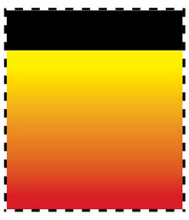Blog
Federal Circuit Rules Color Trademarks Can Be Inherently Distinctive, Vacating TTAB
Fish & Richardson
Authors
-
- Name
- Person title
- Principal

The Federal Circuit Court of Appeals (CAFC) recently held that "color marks" (i.e., trademarks consisting solely of one or more colors without words or designs) can be inherently distinctive, vacating a 2018 Trademark Trial and Appeal Board (TTAB) ruling.[1] While acknowledging that "color is usually perceived as ornamentation," the court reasoned that "a distinct color-based product packaging can indicate the source of the goods to a consumer."
We discussed the TTAB ruling in a previous blog post.[2] In short, the Applicant, Forney Industries, Inc., applied to register the color scheme shown below on the product packaging for metal hardware, welding equipment, safety goods and marking products.
In reviewing the refusal of registration, the TTAB relied on Supreme Court precedent to find that color marks cannot be inherently distinctive.[3] Under that ruling, anyone seeking registration of a color mark would need to prove distinctiveness by providing evidence with their application that consumers associate that color (or colors) with the applicant.
On appeal, the CAFC took issue with the TTAB's failure to differentiate between product design and product packaging. The Court agreed that under binding Supreme Court precedent, color marks as applied to product designs cannot be inherently distinctive since "color is usually perceived as ornamentation." However, it viewed color as applied to product packaging as somewhat different, observing that "a distinct color-based product packaging can indicate the source of the goods to a consumer, and, therefore, can be inherently distinctive."[4]
The CAFC's ruling is good news for companies wishing to register color marks, but it is more limited than it seems. For one, the Court agreed with the applicant that the proposed mark "is not just a 'color mark,' but also a 'symbol.'" Indeed, the CAFC viewed the mark as a particular combination of colors, arranged in a particular design, concluding that these features could serve a source identifying function.[5] This could be construed as leaving open the question of whether a pure color mark used on product packaging could be registered without proof of secondary meaning. It may also incentivize applicants to argue that their color arrangements and combinations serve a symbolic purpose and therefore, function as inherently distinctive marks.
It remains to be seen whether the case will be appealed to the Supreme Court. The CAFC's ruling appears to conflict with dicta in the Wal-Mart v. Samara case, where the Court observed that: "with respect to at least one category of mark—colors—we have held that no mark can ever be inherently distinctive."[6] While the CAFC seemed to think the question of inherent distinctiveness for color marks was different depending on whether or not the color was applied to the goods themselves or their packaging, the Supreme Court did not draw that same distinction, stating: "It seems to us that design, like color, is not inherently distinctive."[7]
For the time being, the CAFC remanded the case to the TTAB to reconsider whether the mark is "sufficiently indicative of the source of the goods contained in that packaging ... based on the overall impression created by both the colors employed and the pattern created by those colors." The TTAB could come to the same conclusion it did before, leaving the applicant (and other similarly situated companies) in the same position it was in back in 2018.
As a practical note, the application in the Forney case was filed in May 2014. It took six years to get to a ruling that is optimistic, but inconclusive. From this, we reiterate the takeaway from our previous article on the Forney case. Anyone wishing to register a color mark should take care to develop evidence of acquired distinctiveness before filing an application. The alternative is costly and time-consuming.
[1] In re Forney Industries, Inc., Appeal No. 20191-1073, 2020 WL 1696314 (Fed. Cir. April 8, 2020).
[2] See also, In re Forney Industries, Inc., 127 USPQ2d 1787 (TTAB 2018).
[3] See e.g., Qualitex Co. v. Jacobson Prods. Co., 514 U.S. 159 (1995) (finding no "obvious theoretical objection to the use of color alone as a trademark" when that color has acquired distinctiveness); Wal-Mart Stores, Inc. v. Samara Bros., Inc., 529 U.S. 205 (2000) (in discussing a trademark for a product design, stating: "with respect to at least one category of mark colors—we have held that no mark can ever be inherently distinctive").
[4] Citing In re Owens-Corning Fiberglas Corp., 774 F.2d 1116, 1124 (Fed. Cir. 1985).
[5] In re Forney, No. 2019-1073, 2020 WL 1696314, at *4 (Fed. Cir. Apr. 8, 2020) ("Forney's proposed mark comprises the color red fading into yellow in a gradient, with a horizontal black bar at the end of the gradient. It is possible that such a mark can be perceived by consumers to suggest the source of the goods in that type of packaging.").
[6] Wal-Mart, 529 U.S. at 211 (emphasis added) citing Qualitex, 514 U.S. at 162—163.
[7] Id. at 212.
Author: Jon Jekel, Lisa Greenwald-Swire
The opinions expressed are those of the authors on the date noted above and do not necessarily reflect the views of Fish & Richardson P.C., any other of its lawyers, its clients, or any of its or their respective affiliates. This post is for general information purposes only and is not intended to be and should not be taken as legal advice. No attorney-client relationship is formed.